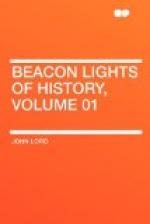Much has been written on those principles upon which Art is supposed to be founded, but not very satisfactorily, although great learning and ingenuity have been displayed. It is difficult to conceive of beauty or grace by definitions,—–as difficult as it is to define love or any other ultimate sentiment of the soul. “Metaphysics, mathematics, music, and philosophy,” says Cleghorn, “have been called in to analyze, define, demonstrate, or generalize,” Great critics, like Burke, Alison, and Stewart, have written interesting treatises on beauty and taste. “Plato represents beauty as the contemplation of the mind. Leibnitz maintained that it consists in perfection. Diderot referred beauty to the idea of relation. Blondel asserted that it was in harmonic proportions. Leigh speaks of it as the music of the age.” These definitions do not much assist us. We fall back on our own conceptions or intuitions, as probably did Phidias, although Art in Greece could hardly have attained such perfection without the aid which poetry and history and philosophy alike afforded. Art can flourish only as the taste of the people becomes cultivated, and by the assistance of many kinds of knowledge. The mere contemplation of Nature is not enough. Savages have no art at all, even when they live amid grand mountains and beside the ever-changing sea. When Phidias was asked how he conceived his Olympian Jove, he referred to Homer’s poems. Michael Angelo was enabled to paint the saints and sibyls of the Sistine Chapel from familiarity with the writings of the Jewish prophets. Isaiah inspired him as




